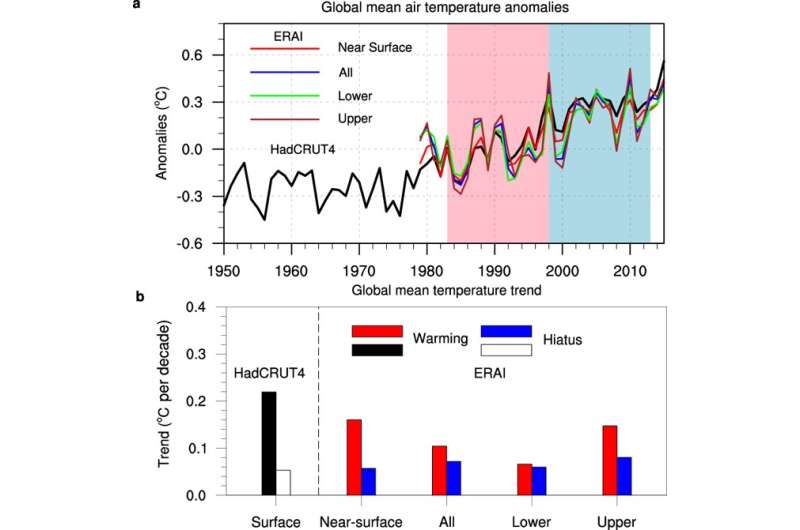Study reveals the atmospheric footprint of global warming hiatus

The increasing rate of the global mean surface temperature was reduced from 1998 to 2013, known as the global warming hiatus, or pause. Researchers have devoted much effort to the understanding of the cause. The proposed mechanisms include the internal variability of the coupled ocean-atmosphere system, ocean heat uptake and redistribution, and many others. However, scientists also want to understand the atmospheric footprint of the recent warming hiatus as the dynamical and physical processes remain unclear.
In a recent paper published in Scientific Reports, LIU Bo and ZHOU Tianjun from the Institute of Atmospheric Physics, Chinese Academy of Sciences, have investigated anomalous atmospheric features during the global warming hiatus period from 1998 to 2013. They show evidence that the global mean tropospheric temperature also experienced a hiatus or pause.
To understand the physical processes that dominate the warming hiatus, they decomposed the total temperature trends into components due to processes related to surface albedo, water vapor, cloud, surface turbulent fluxes and atmospheric dynamics.
The results demonstrated that the hiatus of near-surface temperature warming trend is dominated by the decreasing surface latent heat flux compared with the preceding warming period, while the hiatus of upper tropospheric temperature is dominated by the cloud-related processes. Further analysis indicated that atmospheric dynamics are coupled with surface turbulent heat fluxes over lower troposphere and coupled with cloud processes over upper troposphere.
As to why the surface latent heat flux, atmospheric dynamics and cloud-related processes showed such large differences between 1983-1998 and 1998-2013, LIU, first author of the paper, explained, "They are dominated by the Hadley Circulation and Walker Circulation changes associated with the phase transition of Interdecadal Pacific Oscillation (IPO)."
According to LIU, the IPO is a robust, recurring pattern of sea surface temperature anomalies at decadal time scale. During a positive phase of IPO, the west Pacific and the mid-latitude North Pacific becomes cooler and the tropical eastern ocean warms, while during a negative phase, the opposite pattern occurs. The IPO has shifted from the positive phase to negative phase since 1998/1999, and this transition has led to the weakening of both Hadley Circulation and Walker Circulation, which served as a hub linking the three processes mentioned above.
"Though the heat capacity of the atmosphere is nearly negligible compared with the ocean", said ZHOU, corresponding author of the paper, "understanding the atmospheric footprint is essential to gain a full picture of how internal climate variability such as IPO affects the global climate from the surface to the troposphere. The new findings also provide useful observational metrics for gauging climate model experiments that are designed to understand the mechanism of global warming hiatus."
More information: Bo Liu et al, Atmospheric footprint of the recent warming slowdown, Scientific Reports (2017). DOI: 10.1038/srep40947
Journal information: Scientific Reports
Provided by Chinese Academy of Sciences



















